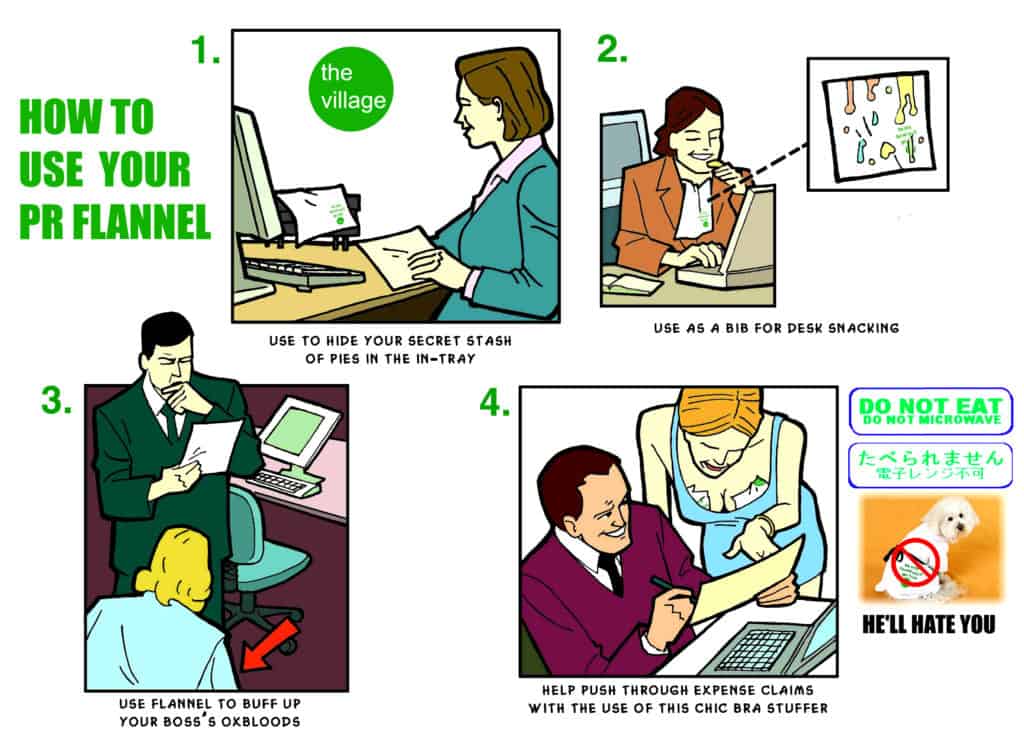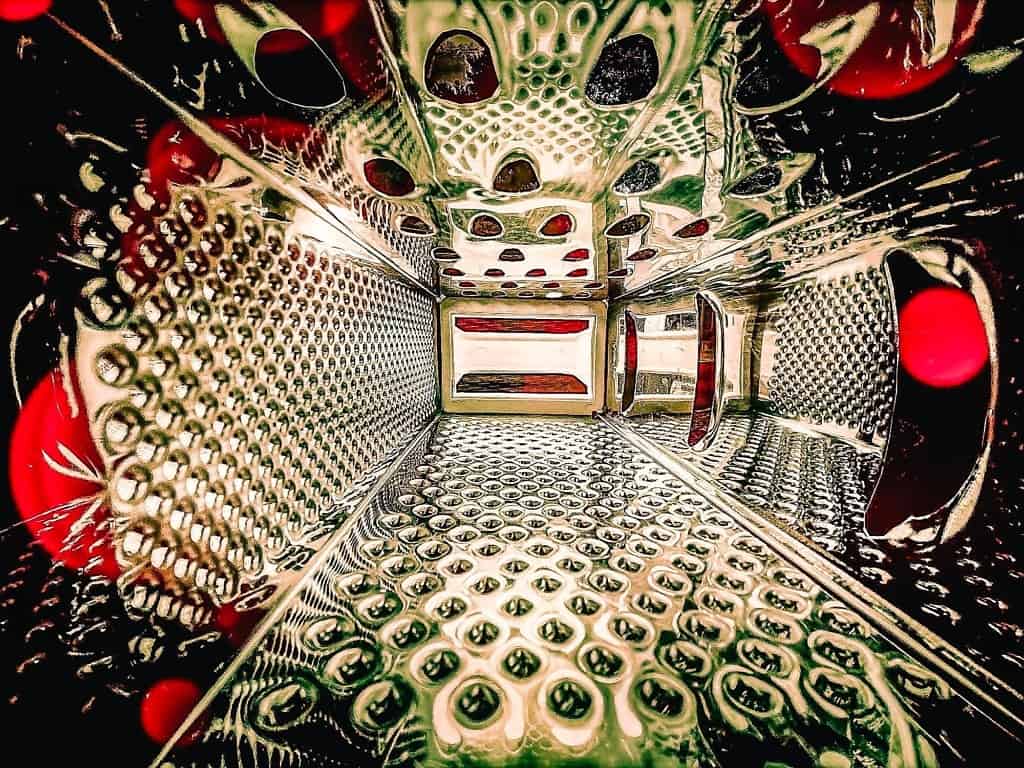I put together this presentation on creativity in public relations and on how to come up with ideas in public relations. A task that is none too easy in many agency environments.
The contents of the slides can be found below:
1. Ways to be Creative Bill Hunt Public Relations
2. First comes strategy, then comes creativity in public relations
• Here is a guide to coming up with ideas, having formed the strategy – here’s a quick reminder of what constitutes strategy… • Strategy is the art/science of formulating, implementing and evaluating cross-functional decisions that enable an organisation to achieve its objectives • A strategy is your plan for how you will get from A to B – how you will achieve the OBJECTIVES • From forming your strategy you are then in a position to come up with a ‘creative platform’ out of which comes your ideas…
3. A taste of things to come:
• What is creativity? • Some myths debunked • The creative process • Brainstorming • Green light thinking • Red light thinking • Obstacles to creativity
4. What is creativity?
• A term widely used – and abused.. often easier to detect than define… • As an individual talent • As a process • As a product • As recognition by others • Arthur Koestler (in 1964) defined it as “two disconnected notions accidentally coming together” • “Disconnected notions” may be the raw material of creating ideas, but it does not automatically equate with generating “creative ideas”…
5. What is more creative? Image of pencil.
6. What is more creative? Image of painting.
7. Defining Creativity: • It could be argued both are equally creative, because they each offer added value in their respective tasks • Professor Morris Stein: “creativity is a process that results in novelty which is accepted as useful, tenable, or satisfying by a significant group of others at some point in time” • When faced with the task of ‘being creative’, we are in a world that is constantly changing (think digital media, guerrilla marketing, iPhone apps, etc)
• What is creativity? • Some myths debunked • The creative process • Brainstorming • Green light thinking • Red light thinking • Obstacles to creativity A taste of things to come Ways to be Creative Bill Hunt Public Relations
8. A Definition for the PR Practitioner:
• PR work creates or manages change. A working definition must therefore contain some form of process and end product “Creativity is the ability each of us has to create something new by bringing together two or more different elements in a new context, in order to provide value to a task.” “A creative task consists of not only originating but also evaluating the added value it contributes. It is not novelty for its own sake, but it must produce some form of value that can be recognised by a third party.”

9. A Context for Creativity: • We don’t have completely ‘free reign’ in PR – the creative platform / tactic must not compromise the brand or organisation values • We all have a level of ‘creativity’ within us • Creativity vs innovation: “Creativity is the thinking process that helps us generate ideas. Innovation is the practical application of such ideas towards meeting the organisation’s objectives in a more effective way.” Professor Simon Majaro, Cranfield School of Management
10. Some Myths Debunked: • Creativity is an incremental process – the Instant Big Idea does not exist • The myth of the left-brain / right brain theory • …but this does help us to categorise: • Convergent thinking – the intellectual ability to logically evaluate, criticise and choose the best idea • Divergent thinking – the ability to think of many original, diverse and elaborate ideas • The myth of ‘lateral thinking’ = creativity – it is the not the same as, or sum of creative thinking, rather a useful tool
11. Title Page: The Creative Process
12. Incubation:
“What I propose to you is the result of a long time pondering.. this has brought me to the conclusion that the production of ideas is just as definite a process as the production of Fords; that the production of ideas, too runs on an assembly line; that in this production the mind follows an operative technique which can be learned and controlled”. James Webb Young, A Technique for Producing Ideas
13. The Five ‘I’s of the Creative Process: • Information • Incubation • Illumination • Integration • Illustration
14. Information: • There are two elements to this stage of the process: • Posing the right questions • Restate the problem in as many ways as you can • Challenge any assumptions you have made about the problem • …this helps you to define the paradigm you face • And gathering the relevant information to assist with the task in hand • Gather information related to the client and market from as many sources as possible • Consume as much media as possible to know what is current
15. Incubation: “Having by a time of very intense concentration planted the problem in my subconscious, it would germinate underground, until suddenly, the solution emerges with blinding clarity, so that it only remained to write down what had happened, as if in a revelation”. Bertrand Russell, Philosopher
16. Incubation: • Poincaré defines incubation as ‘simply the facilitation of problem-solving by the passage of time’ • Incubation is essentially harnessing your subconscious mind into problem solving • It occurs at a deep subconscious level, but also when what is commonly referred to as ‘daydreaming’ • The incubation phase is often neglected (which is why it pays to send out a brief the day before the brainstorm)
17. Illumination: • The most famous example of illumination, which has since become the symbol of scientific discovery is Archimedes cry of “Eureka!” • Illumination often consists of seeing two previously unrelated items and making a link between them for the task in hand • Illumination often occurs during times of ‘low cortical awareness’ • Psychologists have also identified the ‘alpha state’ – the period while just falling asleep or waking • Make sure you’re always able to record your ideas
18. Integration: • Poincaré highlights a final verification stage, to check out that the idea actually works • Ideas are generated while the creator is working in the integration stage of the creative process • The integration stage involves using the incremental nature of the creative process to develop possibly a completely new creative product • Eg while writing a press release – you might think of a useful alliteration or metaphor, and further ideas will emerge
19. Illustration: • Ideas are often enhanced by the way in which they are presented • Selling the idea is a critical stage – don’t believe that an idea will somehow sell itself • For us working in PR, consider: • Legitimizing the source of the idea • Timing • Translating the idea • Keeping within the brand values • Presenting within the context of a relationship
20. Illustration – Translating the Idea: There are two fundamental approaches in the selling of an idea that are often overlooked • The preferred Thinking Mode • And the personality profile of the decision maker
21. Illustration – Translating the Idea: Preferred Thinking Modes • Visual thinking • People whose thought processes makes pictures in their minds • Thought to be around 35% of the population • Auditory thinking • Used by people who like to listen to the way you say things – the pitch, the pace and intonation • Estimated to be 25% of the population • Kinaesthetic thinking • People who decide on ‘gut instinct’ or hunches • Accounts for the remaining 40% of the population
22. Illustration – Translating the Idea: Personality Profiles • ‘Headline’ types or ‘directors’ • Strong on leadership and control their emotions, likely to be independent, energetic, assertive and lively • Like to be in control and making decisions • ‘Illustration’ types or ‘enthusiasts’ • Strong on leadership but also willing to show emotions • Can be thought of as competitive, dynamic excitable and optimistic
23. Illustration: Translating the Idea: Personality Profiles – continued • ‘Logo’ types or ‘team players’ • Low in leadership skills, but high in showing emotions • Likely to be polite, sensitive, accurate and realistic • ‘Body copy’ types or ‘analysts’ • Low in leadership skills and also control their emotions • Perceived as thoughtful, calm, reliable and steady
24. Illustration – Keeping within brand values: Effective creativity must not compromise the brand values of the organisation or product To guard against an over- protective ‘brand guardian’, use the ‘Inoculation Effect’ By stating a potential negative to the creative idea at the outset, you effectively inoculate the proposals against being evaluated negatively by the recipient
25. Title Page: Green Light Thinking – Creative Technique
26. Green Light Thinking – Introduction: There is no magic wand for coming up with ideas, but there are a number of creative techniques • These techniques, coupled with a knowledge and understanding of the five ‘I’s can aid in the creative process • Rather than trying to learn every technique, think about the process behind each one • Test them out, see which ones you’re comfortable with using – and which are effective
27. THE CREATIVE RANGE: Safe Bet Option Extreme Option • You are not looking for the elusive ‘Big Ideas’, but rather small ideas to fit within the Creative Range • This also helps to suspend judgement because you are not automatically screening every idea, but merely filling in the Creative Range Green Light Thinking – 1. Establish the Creative Range

28. Green Light Thinking: Work backwards from the future • Visualise the end objective and work backwards from that point Create an imaginary person • Possibly based on someone in real life, and ask ‘what would they think about this?’ Snakes and ladders • Uses the incremental nature of creativity to quickly establish an overview of a situation identifying strengths and weaknesses Using a metaphor • People can be persuaded to look at something very familiar in a new way by the metaphor technique
29. Image Page: Green Light Thinking – The Snakes and Ladders Technique: Lack of brand awareness Personality of MD Lack of brand credibility Interesting photography Competitor activity Media apathy Forthcoming events / exhibitions News value of story Limited budget Green Light Thinking – The Snakes & Ladders Technique Credit: Andy Green CIPR, Creativity in Public Relations Fourth Edition, Kogan Page
30. Green Light Thinking: Forced combinations • The Matrix Technique can help practitioners generate 36 ideas in 36 seconds. This can be extended even further by combining elements (see over) Random word technique • Good to use by yourself or in small groups. Very quickly generates a range of new connections leading to either specific ideas or suggestions The checklist (SCAMPER) technique • Alex Osborn, a pioneer of creative thinking, used a checklist of ‘change’ words to compare with the situation at hand
31. Green Light Thinking – An example of forced combinations: Ceremonies Celebrities Location Message Tape-cutting Mayor Front of building New era for company Tree planting Sports celebrity Top of building No change for company Plaque unveiling Managing Director In foyer Landmark for company Gift Oldest employee Unusual part of building Celebration of success Handshake Child In front of city landmark Commitment to customer, etc Prop Showbiz celebrity In front of company sign New products
32. Green Light Thinking: The SCAMPER Technique: • Substitute • Combine • Adapt • Modify (make bigger / smaller) • Put to other uses • Eliminate • Reverse
33. Green Light Thinking: The focusing Method • In contrast to the ‘Creative Range’, this method involves concentrating on the one key element within the situation we are working with Attribute Listing • A great technique for ensuring all possible aspects of problem are examined – it breaks the problem down into smaller and smaller bits to ensure all possible aspects of a problem are examined Paradigm Busting • A method to avoid being ‘bound’ by certain assumptions in our analysis
34. Green Light Thinking: Attribute Listing for an Annual Report The Creative Process: Components Medium Print quality Images Photographs’ subject matter Financial information Binding Existing attributes Print Full colour Throughout Photographs Board members, site locations Stock Exchange minimum Information Stapled, stitched Potential ideas Internet, audio, video, etc Printing in black & white, company colours, etc Line drawings, computer-generated imagery, etc Products in use, customers, etc Breakdown of costs of key products, etc Bound with ribbons, metal bolts in hole- punched pages, etc
35. Green Light Thinking – Attribute Listing for an Annual Report: Chart

36. Green Light Thinking – Paradigm Busting: • Although we rely on many methods of communication in everyday life, in problem-solving situations, we too often rely too heavily on one approach • So try using different types of communication • Visually • Verbally • Numerically • Sequentially • Conceptually • Emotionally
Green Light Thinking – Providing a structure to idea generation: Using Six Hats • Edward de Bono developed the ‘Six Hats’ method, designed to break down the thought process into structured stages: • Information gathering • Idea generation • and Critical evaluation • Each stage is marked by a different coloured ‘hat’. Pictured here as six windows.
37. Green Light Thinking: Edward de Bono’s Six Hats: WHITE HAT: At the outset, focuses on the information needs. RED HAT: Represents fire & warmth of feelings. Think of any emotions, intuitions and feelings about the task & express them. GREY HAT: The stage for caution, risk assessment and criticism, where the emphasis is on what can go wrong YELLOW HAT: Characterised by a logical, positive look at the task and looking in parallel for benefits and values. GREEN HAT : Judgement is suspended and the new creative effort is focused on the search for alternatives and new ideas BLUE HAT: The ‘blue sky’ stage, which aims to establish an overview and seeks to orchestrate the thinking process.
38. Mind Mapping • 1. Start with a drawing to act as a central image (and use a selection of colours) • 2. From the original central image, order your thoughts so that they radiate out in sequence of their importance Highlight keyword in capital letters • 3. Highlight the importance of key thoughts with the thickness of lines • 4. Show further connections between your thoughts be connecting lines to each other, linking and associating ideas with loops and arrows. Use happy and sad faces for positive & negative points. • 5. Help remember by using graphic elements or words relating to the senses where possible
39. Mindmap example – Copyright: Paul Foreman www.mindmapinspiration.com

40. James Webb Young: A Technique for Producing Ideas: • An idea is a ‘new combination’ which establishes a relationship between two apparently unconnected facts • The ability to make new combinations is heightened by an ability to see relationships • He then outlines a process similar to the 5 ‘I’s: • 1. Gathering raw material – specific & general • 2. The mental digestive process • 3. Drop the subject and put it out of your mind • 4. “The idea will appear…” • 5. The cold, gray dawn of the morning after
41. Techniques for Encouraging a Creative State of Mind
The Disney Strategy • A technique inspired by Walt Disney also uses a set of distinct stages to encourage creativity • ‘Dreamer’ stage: visualise a place in front of you to step into – you are free to create without any restraints • ‘Realist’ stage: choose a different place, sift the dreams, organise them and act upon them • ‘Critic’ stage: select a place to be a critic, or to evaluate • Now you have created three places, or states of mind, as ‘anchors’ for a particular thought process, and you can visit and revisit all three places at any time
42. Stand up, Incubation Rest, low-cortical awareness break. After 40 minutes or so in a meeting, simply get everyone to stand up, and do anything different. It can include just looking out the window, playing with Lego, swapping seats, swapping gossip about next-door neighbours, etc. Some great writers testify to the merits of giving yourself a break and a change of activity – from going out for a walk, relaxing in a bath, watching a bull terrier frolic in the snow, to taking exercise. This allows for an Incubation Rest or low-cortical- awareness break, during which further illuminations are likely to emerge.
43. Title Page: Green Light Thinking: Brainstorming
44. Green Light Thinking – Brainstorming: “We tried brainstorming once, but nothing came from it. All we got was a lot of far-out ideas.” A common response to a suggestion for a brainstorming session. An umbrella term to describe the process of ‘being creative’ is ‘brainstorming’. Here it is used to describe a formal group technique to generate new ideas. Pioneered by Alex Osborn in the 1950s in his book Applied Imagination, he suggested it should follow two principles – the deferment of judgement and generating quantity of ideas breeding quality.
45. Green Light Thinking: Brainstorming – Osborn’s Rules: • Brainstormers sit in an informal setting • Brainstormers are encouraged to run wildly intellectually • No one should criticize any one else’s idea • The more unusual or crazy the idea the better • The more suggestions the better • Ideas can be combined and recombined • All brainstormers views are sought • All brainstormers are of equal status • The process of generating ideas should be separate from the process of evaluation

46. Green Light Thinking: Brainstorming – Potential Issues: The process needs someone who ‘owns’ the problem, wants to solve it, and can do something about it. Otherwise it can be a self-indulgent waste of time if the session tackles the wrong kind of problem or is unstructured. Some participants tend to be ‘wall-flowers’, while other ‘talkers’ can completely dominate the process. Pressures to conform, deference and organisational politics can influence the extent that people take part. Despite the ‘rule’ of avoiding negativity, ideas are often evaluated, with discussion switching to arguing the case rather than looking for new insights.
47. Green Light Thinking: A New Structured Brainstorming: A senior manager analyses the brief • Situation: describe task & put it into context, with the key outcome stated as clearly as possible • Problems: raised by the brief that need solving • Objectives: Identify any new issues & add to if needed • Audiences: all groups you need to reach – you can be creative by extending the target groups or being more specific & targeted • Messages: Include ones & the brief & think creatively about any you can add • Channels: communication routes to your audiences • Resources: As well as the budget outlined, is there additional funds for extra creative ideas? • Threats: competitive activity, environmental developments, consequences of inactivity
48. Green Light Thinking: A New Structured Brainstorming: Opportunities: Use specific events or topical issues to add value by linking to it): seasonality – winter / spring / summer / autumn, events – theme weeks, days, sports or political events, commemorations, exhibitions, etc. Topicality – film, television, arts or fashion, VIPs – visits, endorsements or links with an organisation. The local area – cultural strengths / weaknesses. Programme: distill strategy & ideas into a coherent campaign, followed by evaluation – think up benchmarks and measures, working creatively, and ‘illustration’ – What ideas will help to sell the programme?
49. Green Light Thinking: A New Structured Brainstorming: Establish criteria • Use Red Light Thinking to establish criteria for evaluating ideas Devise an initial plan • Draft proposal for action, if you need more ideas, circulate to colleagues before the brainstorming session. They should read asap so as to capitalize on their incubation of ideas
50. Green Light Thinking: A New Way: Structured Brainstorming Brainstorming session • Only at this stage Prepare for a brainstorming session . Grab a flipchart, coloured pens and a set of post-it notes or cards • Appoint a ‘cheerleader’ and ‘scribe’, the cheerleader encouraging outrageous ideas, and the scribe (or recording device) recording them • Use Green Light Thinking to generate ideas, allocating a set amount of time to each section of the draft PR proposal • Work through each section described in stage no.1

51. Green Light Thinking: A New Way: Structured Brainstorming: Brainstorming session / continued. If there are enough people, split them up into groups to tackle specific issues – working independently encourages competitiveness. At the outset, set a strict time limit, and stick to it. Andy Green advises on 25 minutes for an optimum brainstorming session. The next day, the coordinator follows up with all participants to gather any further ideas – again capitalising on the incubation stage. The brainstorming session invariably stimulates new thoughts and ideas after the session.
52. Red Light Thinking • The next stage is judging and evaluating the ideas. Place the criteria (established in stage no.2) alongside the ideas noted. Rather than subjectively evaluating individual ideas, the criteria help to introduce an objective appraisal Establish the plan • Using your strategy, and the relevant ideas, begin to establish the programme. Give everyone who took part in the brainstorm a copy for their feedback The Creative Process Green Light Thinking: A New Way: Structured Brainstorming
53. Green Light Thinking: A New Way: Structured Brainstorming: Gain acceptance • Bring into play the illustration stage of the creative process to gain acceptance from those you need to sell the plan to
54. Green Light Thinking: An Aside – The Nominal Group Technique: The Nominal Group Technique (from the IPR Mind Link): Stage one, generate Ideas; Stage two, share Ideas; stage three, clarify and develop the ideas; stage Four, select the best idea; stage five, check the decision; stage six: confirm or modify the decisions.
55. Ideas that are ‘Made to Stick’• The ‘spectrum of memorability’ – ‘Kidney Heist’ vs unveiling of a company strategy • The six principles of ‘sticky ideas 1. Simplicity 2. Unexpectedness 3. Concreteness 4. Credibility 5. Emotions 6. Stories
56. Red Light Thinking: Evaluating Ideas
57. Red Light Thinking: Evaluating the Ideas – An Introduction• Evaluation of the ideas is often the most critical part • Base Green Light Thinking on creation, being uninhibited in thought and stressing the positive • Red Light Thinking emphasizes judgement, reason, evaluation and where things may or may not work • Red Light Thinking focuses on what makes an idea viable, robust from potential criticism and able to survive in order to do justice to the quality of the original idea • Red Light Thinking also prevents subjective judgements of ideas (“I like that one”, “I don’t like that one”…)
58. Red Light Thinking: Evaluating Ideas – Formal Evaluation Methods: Screening Method 1 • Is the idea compatible with the brand values? • Is the idea compatible with the PR objectives and strategy? • Is it legal? • Can it be developed within a realistic budget and timescales? • Is it likely to provide added value? • Are the commitments and risks acceptable? • Does the idea have novelty or has it been used before? Red Light Thinking: Formal Evaluation Methods

59. Red Light Thinking: Evaluating Ideas – Formal Evaluation Methods: Screening Method 2 • Immediately put into action realistic ideas or themes • Intriguing ideas that are still embryonic but that have potential as a starting point for thinking about at a later stage • No-hopers
60. Red Light Thinking: Evaluating Ideas – Formal Evaluation Methods: Second Stage Screening • More detailed screening is possible • Rate the ideas against a specific range of objectives such as ability to promote a certain message • The criteria should be divided between ‘Essential’ and ‘Desirable’ • rate the elements 1-10 under ‘Essential’ and ‘Desirable’ • From these figures, it is possible to establish a scoring system for the ideas and come up with a solution based on the highest score
61. Red Light Thinking: Evaluating Ideas – Benjamin Franklin’s ‘Prudential Algebra’ Technique: • Divide a sheet of paper into two columns with the word ‘Pro’ at the head of one column and ‘Con’ heading the other “..I put down under the different heads short hints that at different times occur to me, for or against the measure. I endeavor to estimate their respective weights; and where I find two (one on each side) that seem equal, I strike them both out … Thus proceeding, I find at length where the balance lies…I come to decision accordingly.” Benjamin Franklin
62. Red Light Thinking: External Evaluation Red Light Thinking: Evaluating Ideas: • Ask a member of your target audience their opinion • Run ideas past a journalist • Consider who you can develop a ‘beta test’ relationship with • Formal external groups representing members of the target audience • YOU decide
63. Title page: Obstacles to Creativity
64. Obstacles to Creativity and Idea Generation: The nature of the problem • Poor Green Light Thinking in the creative process • Overcoming the fear of looking foolish • An intolerance of ambiguity • A preference for judging ideas rather than generating them • A belief that we are not creative • Use of poor creative problem-solving techniques • Stress • Laziness or lack of effort • Habit (the ‘we’ve always done it this way’ syndrome) • A functional fixation • The ‘early bird’ syndrome
65. Obstacles to Creativity and Idea Generation: • Poor Red Light Thinking in the creative process • Confirmation bias • Lack of motivation • Following the rules excessively • A focus on the downside rather than the quality of an idea • An overreliance on logic • Lack of consultation • Excessive reliance on external resources • Emphasis on doing rather than thinking • Being critical or negative • The insecurities of the expert • Poor management of the creative process
66. Obstacles to Idea Generation – Potential Obstacles in the Creative Process: Stage in Creative Process Potential Obstacles Information – Insufficient information to provide raw material of elements to combine and recombine. Failure to define the problem in an ill-structured situation. Incubation – Not enough time for incubation. Illumination – Poor Green Light thinking skills. – Failure to recognise and record illuminations. Integration – Poor Red Light thinking skills in sifting ideas, analysing their qualities and identifying their added value. – Poor technical and professional skills, which can hamper translation of ideas into reality. – The context may be inappropriate for the idea – an idea may be ahead of its time, or overtaken by events. – Poor organisational skills, resulting in the quality of the ideas not being matched by the calibre of the practical application. Illustration – Poor technical; professional and presentation skills, which can undermine the inherent qualities of the idea. As a result, the concept may fail to gain necessary approval from decision makers.
67. The Creative Individual

1. Be uncomfortable – Change your attitude – Limit the risk – Reframing 2. Be a pig, a mule, and a Zebedee 3. Have a role model and a positive anchor 4. Overflowing your jug – Read as many newspapers as possible – Consume a variety of media – And enjoy a variety of experiences, people, and perspectives 5. Take your hunches for lunch
68. The Creative Individual: 6. Work, work and work 7. Parlez PR 8. See the paradox of situations 9. Speak the language of the positive 10. Keep clear goals in mind
69. Summary
• Having read this presentation, you should be equipped with: • A working definition of creativity • An understanding of the nature of creativity • An awareness of the creative process and how to manage it to optimum effect • Ways of overcoming obstacles that limit your creative abilities • A knowledge of Green Light and Red Light thinking • An appreciation of the ingredients that make up the ‘creative individual’
70. About Bill Hunt

I have spent 25 years in public relations, primarily in large agencies including BCW, Hill & Knowlton Strategies and HAVAS PR. I’ve held the position of Creative and / or Digital Director for HAVAS PR, The Village PR and Catalysis. Past ideas include a 7ft drag queen touring clubs to promote a camera for Nikon, having Helen Fielding write the intro to a press release as ‘Bridget Jones’ and sending Bertie Bassett to Sotheby’s to bid on old box of Liquorice Allsorts. I also suggested shooting branded dwarves into the River Thames to launch a mobile game. That idea went nowhere. I now work in the UK as an independent consultant advising agencies and clients.
71. A Quick Note: I have compiled this presentation having read many books on the subject, but much of the credit must go to Andy Green, and his excellent book ‘Creativity in Public Relations’. To get hold of this PR bible containing all you need to know, please click here, or here to buy the ebook. • If I have used your material without attribution, and would like me to add a reference to your book or article, or publish your article to accompany this presentation, please get in touch with me: bill[at]topdogpr.com
72. Go make some ideas. Then join me at topdogpr.com.
